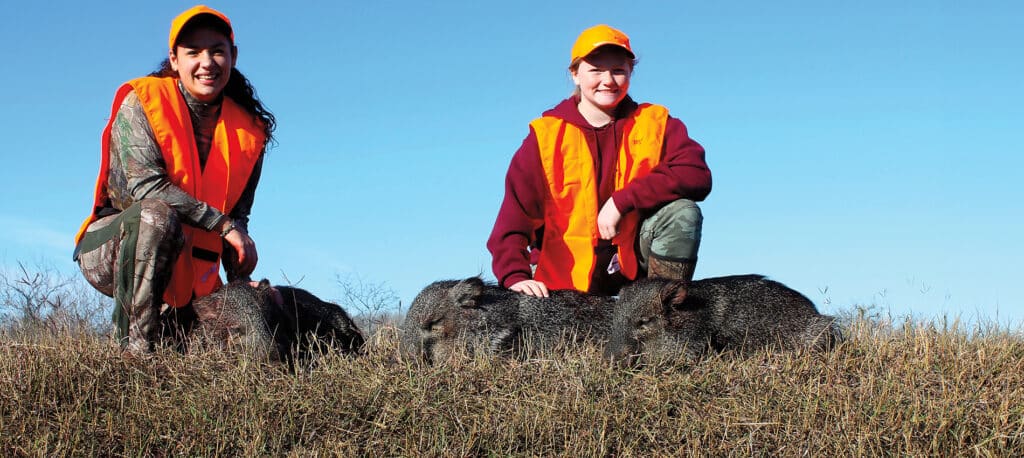
This article is featured in the Spring 2024 issue of Texas LAND magazine. Click here to find out more.
Small changes can have a big impact—and that is the mindset the Texas Wildlife Association’s (TWA) staff and volunteer leaders carry into each new year including 2024.
“In the almost 40 years since TWA’s founding, Texas has changed tremendously— and the organization has evolved with it, while continuing to be the voice of wild places, wild things and the people who care for them,” TWA CEO Justin Dreibelbis said.
Since its inception TWA has worked tirelessly in three arenas: advocacy, education and hunter recruitment. The focus won’t change with the turning calendar page. Instead, the TWA team has identified changes that will enhance the effectiveness of their efforts. Dreibelbis shared some of the priorities and plans for the upcoming year.
Advocacy and Issues
Although the Texas Legislature doesn’t convene in even-numbered years, TWA always keeps a watchful eye on the state capitol. At least 15 veteran legislators are not running for reelection to the state house or senate in November, which means TWA will focus on building new relationships.
“Our primary advocacy role is educating legislators about the value of private land stewardship and serving as a resource for them and their staffs on conservation issues,” Dreibelbis said. “To do that effectively, we have to establish relationships built on trust.”
As TWA builds new relationships (and maintains existing ones), a common theme emerges in the discussions. Because of Texas’ exponential growth—1,400 people per day are moving into the state and that has propelled the total population to more than 30 million—demand for natural resources is increasing at a mindboggling rate putting unprecedented pressure on the state’s natural infrastructure.
“It would be crazy for us and the landowners we represent to put our heads in the sand and pretend that Texas isn’t going to grow anymore,” Dreibelbis said. “Instead, we have to focus on how the state grows responsibly and thoughtfully, while representing the interests of landowners in a way that allows them to stay on their ranches and keep the land productive.”
To that end, TWA’ers are keeping a close eye on all things related to water. Without intervention, Texas is predicted to have widespread water shortages by 2050. Water is already being mined in rural Texas and piped to meet the needs of urban Texas, creating shortfalls for rural communities, rural well owners and agriculture pursuits.
“We can’t live without water,” Dreibelbis said. “That’s not an exaggeration. That is fact.”
Another issue that has TWA’s attention is the unchecked, unregulated expansion of wind and solar energy infrastructure. Texas is the nation’s leading producer of wind energy and its second largest producer of solar energy.
Despite their “green” reputation, both wind and solar power leave an industrial footprint on the land as do their associated storage facilities and transmission lines. Infrastructure construction hastens land fragmentation and impacts wildlife and habitat.
During this past legislative session, a bill was introduced that would have created some oversight over solar and wind farm development sites from an environmental standpoint. It did not pass.
“In Texas, renewable energy development is the wild, wild West,” Dreibelbis said. “There is no real siting process or oversight despite its obvious long-term impacts.
“While we want landowners to be able to secure new revenue streams, we also have a responsibility to the environment. Renewable energy expansion should be undertaken with the same long-term thoughtfulness as any other growth.”
Chronic wasting disease (CWD), a fatal neurological disease affecting white-tailed deer, mule deer, elk and other members of the deer family, is another issue of concern. The disease was first detected in Texas in 2012 and now has spread to 28 counties at the time of this writing.
TWA is committed to protecting Texas’ white-tailed deer herd and the hunting tradition associated with it. For Texas landowners and rural communities, white-tailed deer hunting is vital.
In December 2023, Texas A&M’s Department of Rangeland, Wildlife and Fisheries Management released a report that estimated white-tailed deer hunters generated an estimated $4.6 billion in economic output. The same report calculated landowners supporting white-tailed deer hunting generated an estimated $5 billion in economic output. That money circulates through the state economy with an inordinate impact in rural areas.
On top of that, hunters and anglers pay for the lion’s share of public conservation through excise taxes on sporting equipment. Hunting and fishing license sales also directly fund conservation. In Texas, an average of 1.7 million hunting and combo licenses are sold annually, with a reported 753,000 white-tailed deer hunters contributing to the big game harvest estimates in 2022-2023 season. Fewer hunters mean fewer dollars for conservation.
CWD is spread when infected animals (or their bodily fluids) come into contact with healthy animals. Because of proximity, deer raised in confinement are at higher risk for contracting the diseases. Sick animals may show no symptoms for years.
Texas allows deer raised in confinement to be transported and released, which increases the risk of spreading the disease. At a recent, Texas Parks and Wildlife Commission meeting a rule package was considered to help control the disease. About one half of the measures passed, while the other half was tabled.
Permanent identification of transported and released deer was one of the measures tabled. TWA will continue to push for this commonsense solution, which by the team’s analysis already exists in law, but is unenforced. Despite arguments to the contrary, the measure is not a threat to the deer breeding industry’s viability but a commonsense biosecurity measure.
“If, as a state, we’re going to continue to increase the risk of spreading the disease by hauling deer up and down the highway and introducing them into a new location, it just makes sense to be able to identify those animals,” Dreibelbis said. “It is another level of security.
“Permanent identification allows those animals to be traced and perhaps more importantly allows neighboring landowners, who didn’t transport and release those animals, to immediately know they don’t belong if they escape the original release site.”
Organizational Upgrades
In a quest to better serve its members and all Texans, TWA has several organizational changes on tap for 2024 including upgrading its communications efforts.
“For the first-time in several years, we’re hiring a communications director to develop an efficient, effective overarching communications strategy designed to tell TWA’s story to our members and the public,” Dreibelbis said. Plans are already in the works to revamp the association’s magazine and its distribution while supplementing it with electronic newsletters and a variety of other information sources.
The Texas Youth Hunting Program, which has introduced more than 30,000 young Texans and their significant adults to hunting since its inception in 1996, is adding more non-consumptive options to its offering.
“Hunting is not the only way for people to connect to the outdoors, so we will be offering additional options such as fishing, nature photography and camping under the umbrella of TYHP,” Dreibelbis said. “Our ultimate goal is forging connections between Texans and the land and educating them on the role that private land stewardship plays in providing healthy natural resources for all Texans.”
And the much younger, but wildly popular, Adult Learn to Hunt program is expanding. In 2024, the team will add more hunts to help meet the skyrocketing demand as well as social and educational events to expand the experience beyond the field.
“With an infusion of human capital to expand our capacity, we’re going to promote continued growth by hosting a variety of events including wild game cooking classes and happy hours targeted to our newest hunters,” Dreibelbis said. “Our goal is to usher novice hunters into the tradition and create opportunities for them to build their own hunting communities.”
In the realm of conservation education, which operates under the banner of Conservation Legacy, TWA increased the number of regional conservation educators by two in 2023 bringing the total number to eight. Each conservation educator delivers classroom and field experiences in multiple counties.
Houston and DFW have two, while Austin and San Antonio have one. Two additional conservation educators, who are employed by the East Foundation, deliver TWA classroom lessons and teacher workshops in South Texas.
Last year alone, Conservation Legacy impacted almost 452,000 Texans including students and teachers as well as adult members of the public.
And that number will grow with the addition of a new educator in San Angelo. The community has undertaken a fundraising effort that will cover the cost of having a conservation educator serving San Angelo and the surrounding area.
“When communities get involved to bring conservation education to their students, it’s a win-win,” Dreibelbis said. “The next generation of Texans gets a direct connection to the environment outside their classrooms and the conservation educators are ushered in with the full support and resources of the community.”
And like communities, organizations want to improve life for the people who are part of them.
“TWA has some big things planned for 2024, but at the end of the day we’re going to try to get better at the things we’re already good at—staying focused on the mission and increasing our impact,” Dreibelbis said.
A FEW GOOD LINKS
Check out these links below to get more information on some of the things going on at TWA.
Texas Wildlife Association Events, click here
Adult Learn to Hunt Program, click here
Texas Youth Hunting Program, click here
Conservation Legacy Hands-on conservation education
offered in classrooms and in the field, click here
Texas WildLife 2024 TWA’s 39th Annual Convention
July 11, 2024 – July 14, 2024—San Antonio, Texas, click here

